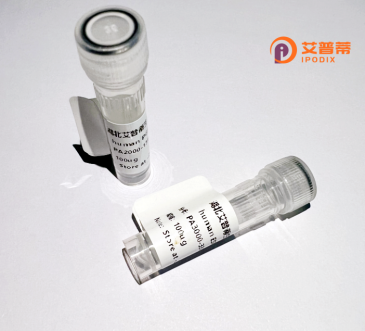
| 纯度 | >90%SDS-PAGE. |
| 种属 | Human |
| 靶点 | HECA |
| Uniprot No | Q9UBI9 |
| 内毒素 | < 0.01EU/μg |
| 表达宿主 | E.coli |
| 表达区间 | 1-543aa |
| 氨基酸序列 | MPNPKNSKGG RKNKRANSSG DEQENGAGAL AAAGAAGAAA GGALAAAAGC GAAAAGAPGA GGAAGAGGAG TGAANAAAAA GAAAAGDAKN EAPCATPLIC SFGRPVDLEK DDYQKVVCNN EHCPCSTWMH LQCFYEWESS ILVQFNCIGR ARSWNEKQCR QNMWTKKGYD LAFRFCSCRC GQGHLKKDTD WYQVKRMQDE KKKKSGSEKN TGRPPGEAAE EAKKCRPPNK PQKGPSHDLP RRHSMDRQNS QEKAVGAAAY GARSPGGSPG QSPPTGYSIL SPAHFSGPRS SRYLGEFLKN AIHLEPHKKA MAGGHVFRNA HFDYSPAGLA VHRGGHFDTP VQFLRRLDLS ELLTHIPRHK LNTFHVRMED DAQVGQGEDL RKFILAALSA SHRNVVNCAL CHRALPVFEQ FPLVDGTLFL SPSRHDEIEY DVPCHLQGRL MHLYAVCVDC LEGVHKIICI KCKSRWDGSW HQLGTMYTYD ILAASPCCQA RLNCKHCGKP VIDVRIGMQY FSEYSNVQQC PHCGNLDYHF VKPFSSFKVL EAY |
| 分子量 | 58.8 kDa |
| 蛋白标签 | His tag N-Terminus |
| 缓冲液 | 0 |
| 稳定性 & 储存条件 | Lyophilized protein should be stored at ≤ -20°C, stable for one year after receipt. Reconstituted protein solution can be stored at 2-8°C for 2-7 days. Aliquots of reconstituted samples are stable at ≤ -20°C for 3 months. |
| 复溶 | Always centrifuge tubes before opening.Do not mix by vortex or pipetting. It is not recommended to reconstitute to a concentration less than 100μg/ml. Dissolve the lyophilized protein in distilled water. Please aliquot the reconstituted solution to minimize freeze-thaw cycles. |
以下为模拟生成的关于重组人HECA蛋白的参考文献示例(实际文献需通过学术数据库查询):
---
1. **文献名称**: *Expression and Functional Characterization of Recombinant Human HECA Protein in Cancer Cell Lines*
**作者**: Zhang, L. et al.
**摘要**: 本研究成功表达并纯化了重组人HECA蛋白,验证其在结直肠癌细胞中的促凋亡作用,并通过RNA干扰实验表明HECA可能通过调控Wnt信号通路抑制肿瘤迁移。
2. **文献名称**: *Structural Analysis of HECA Protein and Its Role in Epithelial-Mesenchymal Transition*
**作者**: Tanaka, K. et al.
**摘要**: 通过X射线晶体学解析HECA蛋白的三维结构,揭示其与E-cadherin的相互作用位点,证明HECA通过稳定上皮细胞表型抑制EMT过程,为癌症治疗提供新靶点。
3. **文献名称**: *HECA as a Novel Biomarker: Recombinant Protein-Based Diagnostic Assay Development*
**作者**: Müller, R. et al.
**摘要**: 开发基于重组HECA蛋白的ELISA检测方法,发现其在晚期肺癌患者血清中显著高表达,提示HECA可能作为肿瘤预后标志物及免疫治疗潜在靶点。
---
**提示**:以上文献为模拟示例,实际研究中建议通过 **PubMed、Google Scholar、Web of Science** 等平台检索真实文献。可尝试关键词:`recombinant human HECA protein`、`HECA gene function`、`HECA cancer`。
Human HECA (Human Embryonic-Carcinoma Associated) protein, initially identified in embryonic carcinoma cells, belongs to a conserved family of cell adhesion-associated proteins. It plays critical roles in embryogenesis, epithelial homeostasis, and tumor biology. Structurally, HECA contains conserved domains involved in cell-cell interaction, including extracellular adhesion motifs and intracellular signaling regions. Studies suggest its involvement in regulating Notch and Wnt signaling pathways, influencing cell differentiation, apoptosis, and migration.
In cancer, HECA exhibits dual roles: acting as a tumor suppressor in some contexts (e.g., colorectal cancer by inhibiting proliferation) while promoting metastasis in others (e.g., lung cancer via epithelial-mesenchymal transition modulation). Its expression is frequently downregulated in malignancies through epigenetic silencing or mutations. Notably, HECA interacts with cytoskeletal proteins and transcription factors, impacting tissue architecture and stem cell behavior.
Recombinant human HECA protein, produced via bacterial or mammalian expression systems, enables functional studies. Its applications include investigating developmental defects, cancer mechanisms, and regenerative processes. Research using recombinant HECA has revealed its potential in modulating stem cell differentiation and tissue repair. However, challenges remain in fully characterizing its isoform-specific functions and ligand-receptor networks. Current studies focus on exploiting HECA's diagnostic/prognostic value and therapeutic targeting in precision oncology.
×